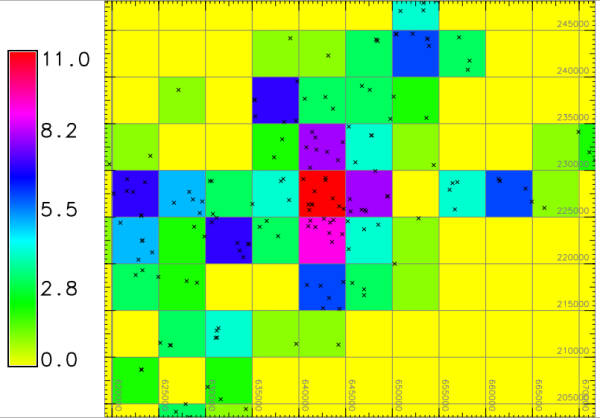
Note: A new GRASS GIS stable version has been released: GRASS GIS 7.4, available here.
Updated manual page: here
NAME
v.to.rast - Converts (rasterize) a vector map into a raster map.KEYWORDS
vector, conversion, raster, rasterizationSYNOPSIS
Flags:
- -d
- Create densified lines (default: thin lines)
- All cells touched by the line will be set, not only those on the render path
- --overwrite
- Allow output files to overwrite existing files
- --help
- Print usage summary
- --verbose
- Verbose module output
- --quiet
- Quiet module output
- --ui
- Force launching GUI dialog
Parameters:
- input=name [required]
- Name of input vector map
- Or data source for direct OGR access
- layer=string
- Layer number or name
- Vector features can have category values in different layers. This number determines which layer to use. When used with direct OGR access this is the layer name.
- Default: 1
- type=string[,string,...]
- Input feature type
- Options: point, line, area
- Default: point,line,area
- cats=range
- Category values
- Example: 1,3,7-9,13
- where=sql_query
- WHERE conditions of SQL statement without 'where' keyword
- Example: income < 1000 and inhab >= 10000
- output=name [required]
- Name for output raster map
- use=string [required]
- Source of raster values
- Options: attr, cat, val, z, dir
- attr: read values from attribute table
- cat: use category values
- val: use value specified by value option
- z: use z coordinate (points or contours only)
- dir: output as flow direction (lines only)
- attribute_column=name
- Name of column for 'attr' parameter (data type must be numeric)
- rgb_column=name
- Name of color definition column (with RRR:GGG:BBB entries)
- label_column=name
- Name of column used as raster category labels
- value=float
- Raster value (for use=val)
- Default: 1
- memory=integer
- Maximum memory to be used (in MB)
- Cache size for raster rows
- Default: 300
Table of contents
DESCRIPTION
v.to.rast transforms GRASS vector map layers into GRASS raster map layer format. Optionally, attributes can be converted into raster category labels.NOTES
v.to.rast will only affect data in areas lying inside the boundaries of the current geographic region. A grid cell belongs to the area where the grid cell center falls into.Before running v.to.rast, the user should therefore ensure that the current geographic region is correctly set and that the region resolution is at the desired level.
Either the column parameter or the value parameter must be specified. The use option may be specified alone when using the dir option.
use options are:
- attr - read values from attribute table (default)
- cat - read values from category
- val - use value specified by value option
- z - use z coordinate (points or contours only)
- dir - output as flow direction in degrees (lines only)
The column parameter uses an existing column from the vector map database table as the category value in the output raster map. Existing table columns can be shown by using db.describe.
An empty raster map layer will be created if the vector map layer has not been assigned category/attribute labels (e.g., through use of v.category option=add).
Otherwise:
-
Labeled areas and/or centroids will produce filled raster coverages with edges
that straddle the original area boundary as long as the boundary is NOT
labeled.
(Use v.category option=del type=boundary to remove.) - Labeled lines and boundaries will produce lines of raster cells which touch the original vector line. This tends to be more aggressive than area-only conversions.
- Points and orphaned centroids will be converted into single cells on the resultant raster map.
Flow directions are given in degrees counterclockwise from east.
Raster category labels are supported for all of use= except use=z.
The -d flag applies only to lines, the default is only those on the render path (thin line).
EXAMPLES
Convert a vector map and use column SPEED from attribute table
db.describe -c table=vect_map ncols:3 Column 1: CAT Column 2: SPEED Column 3: WIDTH
v.to.rast input=vect_map output=raster_map attribute_column=SPEED
Calculate stream directions from a river vector map (Spearfish)
v.to.rast input=streams output=streamsdir use=dir
Convert a vector polygon map to raster including descriptive labels (Spearfish)
v.to.rast input=fields output=myfields use=attr attribute_column=cat label_column=label r.category myfields
Convert vector points to raster with raster cell binning
In this example, the number of schools per raster cell are counted (North Carolina sample dataset):
g.copy vector=schools_wake,myschools_wake
# set computation region for raster binning
g.region vector=myschools_wake res=5000 -p -a
# add new column for counting
v.db.addcolumn myschools_wake column="value integer"
v.db.update myschools_wake column=value value=1
# verify attributes
v.db.select myschools_wake column=cat,value
v.out.ascii input=myschools_wake output=- column=value
# export and import on the fly, use 4th column (value) as input
v.out.ascii input=myschools_wake output=- column=value | r.in.xyz input=- \
z=4 output=schools_wake_aggreg method=sum
d.mon wx0
d.rast schools_wake_aggreg
d.vect schools_wake
d.grid 5000

Number of schools per raster cell
SEE ALSO
db.describe, v.categoryAUTHORS
Original code: Michael Shapiro, U.S. Army Construction Engineering Research LaboratoryGRASS 6.0 updates: Radim Blazek, ITC-irst, Trento, Italy
Stream directions: Jaro Hofierka and Helena Mitasova
GRASS 6.3 code cleanup and label support: Brad Douglas
Last changed: $Date: 2015-07-23 18:39:34 -0700 (Thu, 23 Jul 2015) $
SOURCE CODE
Available at: v.to.rast source code (history)
Note: A new GRASS GIS stable version has been released: GRASS GIS 7.4, available here.
Updated manual page: here
Main index | Vector index | Topics index | Keywords index | Full index
© 2003-2018 GRASS Development Team, GRASS GIS 7.0.7svn Reference Manual